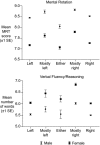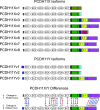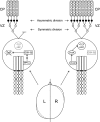The protocadherin 11X/Y (PCDH11X/Y) gene pair as determinant of cerebral asymmetry in modern Homo sapiens
- PMID: 23600975
- PMCID: PMC3752934
- DOI: 10.1111/nyas.12042
The protocadherin 11X/Y (PCDH11X/Y) gene pair as determinant of cerebral asymmetry in modern Homo sapiens
Abstract
Annett's right-shift theory proposes that human cerebral dominance (the functional and anatomical asymmetry or torque along the antero-posterior axis) and handedness are determined by a single "right-shift" gene. Familial transmission of handedness and specific deviations of cerebral dominance in sex chromosome aneuploidies implicate a locus within an X-Y homologous region of the sex chromosomes. The Xq21.3/Yp11.2 human-specific region of homology includes the protocadherin 11X/Y (PCDH11X/Y) gene pair, which encode cell adhesion molecules subject to accelerated evolution following the separation of the human and chimpanzee lineages six million years ago. PCDH11X and PCDH11Y, differentially regulated by retinoic acid, are highly expressed in the ventricular zone, subplate, and cortical plate of the developing cerebral cortex. Both proteins interact with β-catenin, a protein that plays a role in determining axis formation and regulating cortical size. In this way, the PCDH11X/Y gene pair determines cerebral asymmetry by initiating the right shift in Homo sapiens.
© 2013 New York Academy of Sciences.
Figures




Similar articles
-
The XY gene hypothesis of psychosis: origins and current status.Am J Med Genet B Neuropsychiatr Genet. 2013 Dec;162B(8):800-24. doi: 10.1002/ajmg.b.32202. Epub 2013 Oct 3. Am J Med Genet B Neuropsychiatr Genet. 2013. PMID: 24123874 Free PMC article. Review.
-
Protocadherin 11X/Y a human-specific gene pair: an immunohistochemical survey of fetal and adult brains.Cereb Cortex. 2013 Aug;23(8):1933-41. doi: 10.1093/cercor/bhs181. Epub 2012 Jun 28. Cereb Cortex. 2013. PMID: 22744706 Free PMC article.
-
PCDH11 is X/Y homologous in Homo sapiens but not in Gorilla gorilla and Pan troglodytes.Cytogenet Genome Res. 2006;114(2):137-9. doi: 10.1159/000093329. Cytogenet Genome Res. 2006. PMID: 16825765
-
Replication profile of PCDH11X and PCDH11Y, a gene pair located in the non-pseudoautosomal homologous region Xq21.3/Yp11.2.Chromosome Res. 2007;15(4):485-98. doi: 10.1007/s10577-007-1153-y. Epub 2007 May 29. Chromosome Res. 2007. PMID: 17671842 Free PMC article.
-
The 'big bang' theory of the origin of psychosis and the faculty of language.Schizophr Res. 2008 Jul;102(1-3):31-52. doi: 10.1016/j.schres.2008.03.010. Epub 2008 May 23. Schizophr Res. 2008. PMID: 18502103 Review.
Cited by
-
Genome-Wide Association Studies of Schizophrenia and Bipolar Disorder in a Diverse Cohort of US Veterans.Schizophr Bull. 2021 Mar 16;47(2):517-529. doi: 10.1093/schbul/sbaa133. Schizophr Bull. 2021. PMID: 33169155 Free PMC article.
-
Transcriptomic sex differences in early human fetal brain development.Commun Biol. 2025 Apr 25;8(1):664. doi: 10.1038/s42003-025-08070-3. Commun Biol. 2025. PMID: 40281071 Free PMC article.
-
The many faces of neuroendocrine differentiation in prostate cancer progression.Front Oncol. 2014 Mar 25;4:60. doi: 10.3389/fonc.2014.00060. eCollection 2014. Front Oncol. 2014. PMID: 24724054 Free PMC article. Review.
-
The XY gene hypothesis of psychosis: origins and current status.Am J Med Genet B Neuropsychiatr Genet. 2013 Dec;162B(8):800-24. doi: 10.1002/ajmg.b.32202. Epub 2013 Oct 3. Am J Med Genet B Neuropsychiatr Genet. 2013. PMID: 24123874 Free PMC article. Review.
-
Multilocus genetic models of handedness closely resemble single-locus models in explaining family data and are compatible with genome-wide association studies.Ann N Y Acad Sci. 2013 Jun;1288(1):48-58. doi: 10.1111/nyas.12102. Epub 2013 Apr 30. Ann N Y Acad Sci. 2013. PMID: 23631511 Free PMC article.
References
-
- Owen CM, Howard A, Binder DK. Hippocampus minor, calcar avis, and the Huxley-Owen debate. Neurosurgery. 2009;65:1098–1105. - PubMed
-
- Broca P. Rapport sur un memoire de M. Armand de Fleury intitulé: de l'inegalité dynamique des deux hemisphères cerébraux. Bulletins de l’Academie de Medicine. 1877;6:528–539.
-
- Gratiolet P. Anatomie Compare du Systeme Nerveux, Considere Dans ses Rapports avec L'intelligence. Paris: J.B. Bailliere et Fils; 1839.
-
- Yakovlev PI, Rakic P. Patterns of decussation of bulbar pyramids and distribution of pyramidal tracts on two sides of the spinal cord. Trans. Am. Neurol. Assoc. 1966;91:366–367.
MeSH terms
Substances
LinkOut - more resources
Full Text Sources
Other Literature Sources
Molecular Biology Databases

